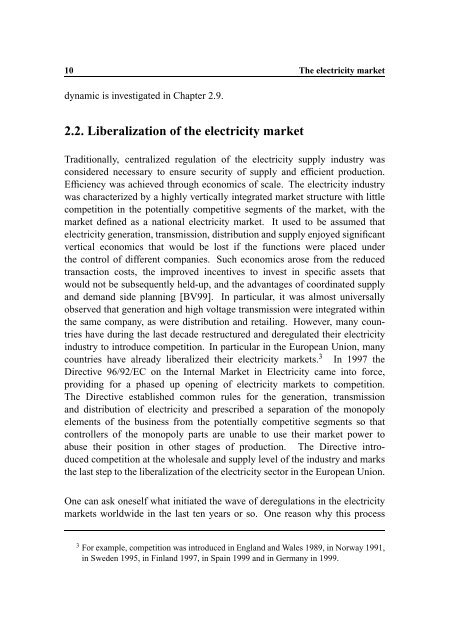Hedging Strategy and Electricity Contract Engineering - IFOR
Hedging Strategy and Electricity Contract Engineering - IFOR
Hedging Strategy and Electricity Contract Engineering - IFOR
Create successful ePaper yourself
Turn your PDF publications into a flip-book with our unique Google optimized e-Paper software.
10 The electricity market<br />
dynamic is investigated in Chapter 2.9.<br />
2.2. Liberalization of the electricity market<br />
Traditionally, centralized regulation of the electricity supply industry was<br />
considered necessary to ensure security of supply <strong>and</strong> efficient production.<br />
Efficiency was achieved through economics of scale. The electricity industry<br />
was characterized by a highly vertically integrated market structure with little<br />
competition in the potentially competitive segments of the market, with the<br />
market defined as a national electricity market. It used to be assumed that<br />
electricity generation, transmission, distribution <strong>and</strong> supply enjoyed significant<br />
vertical economics that would be lost if the functions were placed under<br />
the control of different companies. Such economics arose from the reduced<br />
transaction costs, the improved incentives to invest in specific assets that<br />
would not be subsequently held-up, <strong>and</strong> the advantages of coordinated supply<br />
<strong>and</strong> dem<strong>and</strong> side planning [BV99]. In particular, it was almost universally<br />
observed that generation <strong>and</strong> high voltage transmission were integrated within<br />
the same company, as were distribution <strong>and</strong> retailing. However, many countries<br />
have during the last decade restructured <strong>and</strong> deregulated their electricity<br />
industry to introduce competition. In particular in the European Union, many<br />
countries have already liberalized their electricity markets. 3 In 1997 the<br />
Directive 96/92/EC on the Internal Market in <strong>Electricity</strong> came into force,<br />
providing for a phased up opening of electricity markets to competition.<br />
The Directive established common rules for the generation, transmission<br />
<strong>and</strong> distribution of electricity <strong>and</strong> prescribed a separation of the monopoly<br />
elements of the business from the potentially competitive segments so that<br />
controllers of the monopoly parts are unable to use their market power to<br />
abuse their position in other stages of production. The Directive introduced<br />
competition at the wholesale <strong>and</strong> supply level of the industry <strong>and</strong> marks<br />
the last step to the liberalization of the electricity sector in the European Union.<br />
One can ask oneself what initiated the wave of deregulations in the electricity<br />
markets worldwide in the last ten years or so. One reason why this process<br />
3 For example, competition was introduced in Engl<strong>and</strong> <strong>and</strong> Wales 1989, in Norway 1991,<br />
in Sweden 1995, in Finl<strong>and</strong> 1997, in Spain 1999 <strong>and</strong> in Germany in 1999.
















